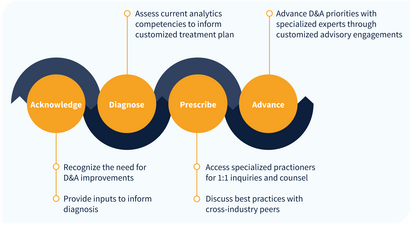Client Inquiry:
Do you have any advice for buying a tool for master data management (MDM)?
Expert Takeaways:
Slow Down
Organizations often make the mistake of buying an MDM tool before they’ve assessed their needs. Slow down. Don’t buy a tool yet.
- Start with your requirements. Let the requirements define your data definitions. Let your data definitions define your data model. Let your data model define the data architecture for the data, which then derives your technical architecture.
- With the technical architecture, you can consider which MDM tool will satisfy the architecture for the data you’re trying to master.
- Don’t feel obligated to select one tool. You could pick different, powerful AI-powered tools for different pieces of master data, such as the customer master data.
- Multidomain MDM tools like Informatica are heavy and not as agile, and they’re very expensive. They’re not really good at any one thing.
Affinity Analysis
After selecting the critical attributes for the organization, use affinity analysis to help you assess your needs. Affinity analysis pinpoints the relationship between data, processes, and systems in your organization.
- Start with affinity between data and systems. Identify all of the systems in the organization that touch the attributes, and create a CRUD matrix—create, read, update, delete.
- What is the CRUD for each attribute? Does a given system create the attribute? Read it? Update it? Delete it? This can show you duplicate attributes across multiple systems and if an updating system is overriding information.
- Perform the same analysis between data and processes. Apply CRUD to the key business functions that get touched or impacted by each attribute. For example, for customer address, which processes create, read, change, and update it?
- Should these processes actually be doing this? This factors into data quality issues you may be having. Now you can identify the business processes that really need to be creating these attributes.
- Assess feeds across processes that don’t align. In MDM, some attributes are managed by a certain process, others by other processes. Now you can identify the stakeholders and groups that should own the different parts of the data.
- The last affinity is the intersection between process and system. Mark an X at the intersection. Look at whether the processes are implemented in the same systems that change the data, and whether that’s the right thing to do.
Stewardship Model
From affinity analysis, identify ownership across processes. That’s going to give you an idea of where your stewardship needs to sit. Use a hybrid federated model.
- Identify the business areas that manage different components of master data. So that’s one steward per function. These are the functional data stewards for MDM.
- You also need an enterprise MDM steward to oversee the big picture, defining the architecture and coordinating the relationship and interactions across the value chain and the stewards.
- Set up a stewardship group at the enterprise level with the stewards as members. The stewards adhere to the MDM rules and standards defined by the enterprise.
- Each functional steward can have some level of freedom locally. For example, for customer address, the representation of addresses needs to be localized by region. The stewards have the freedom to define their own rules of validation for their own segments.
- The enterprise system ensures enforcement both at the local and enterprise level.
“With the help of IIA Experts we were able to get multiple relevant perspectives on our issues quickly and efficiently without need for engaging expensive consultants.”
Expert Network
IIA provides guided access to our network of over 150 analytics thought leaders, practitioners, executives, data scientists, data engineers with curated, facilitated 1-on-1 interactions.
- Tailored support to address YOUR specific initiatives, projects and problems
- High-touch onboarding to curate 1-on-1 access to most relevant experts
- On-demand inquiry support
- Plan validation and ongoing guidance to advance analytics priority outcomes
- Monthly roundtables facilitated by IIA experts on the latest analytics trends and developments
